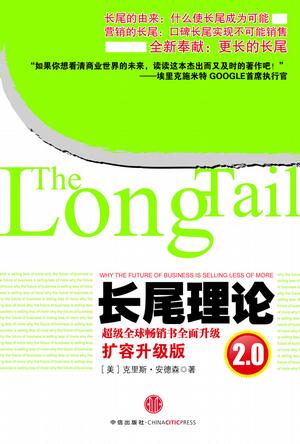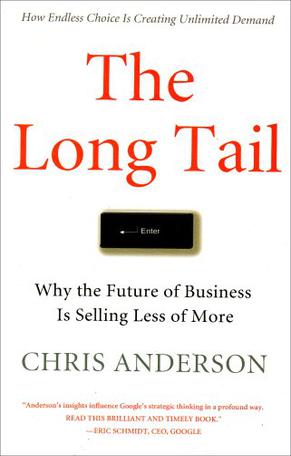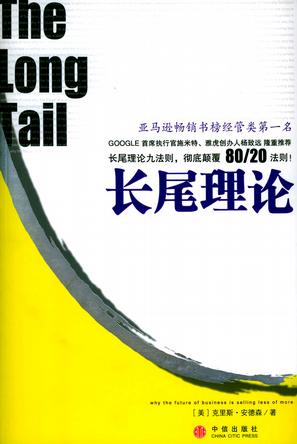欢迎来到相识电子书!
标签:长尾
-
长尾理论2.0
《长尾理论2.0》是克里斯·安德森对所有问题最明确的回答。在此书中,他详细阐释了长尾的精华所在,揭示了长尾现象是如何从工业资本主义原动力——规模经济与范围经济——的矛盾中产生出来的。长尾现象虽然是明显的互联网现象,但其商务逻辑本身,却是从工业经济中自然而然“长”出来的,网络只是把酝酿了几十年的供应链革命的诸多要素简单地结合在一起了。同时,长尾理论转化为行动,最有力、最可操作的就是营销长尾,通过口碑营销,长尾理论将在不可能情况下实现销售。所有的行业都有无限多样化的顾客。品种多样化趋势推动了从机构到个人的权利转移,在这一过程中控制着网络对话的人不是营销人员,而是用户。营销长尾带来了可信任的、真实的、自然发展的、自下而上的、基层民众的意见,并最终影响到21世纪消费者的行为。 建议所有的商务人士都仔细研读这本“杰出而又及时的著作”。长尾理论是众多企业成功的不二法门,它将改变企业营销与生产的思维,带动新一波商业势力的消长。而长尾理论的影响不仅限于企业战略,也将左右人们的品位与价值判断。大众文化不再万夫莫故,小众文化也将有越来越多的拥护者。唯有充分利用长尾理论的人,才能在未来呼风唤雨。 点击链接进入新版: 长尾理论 点击链接进入英文版: Long Tail, The, Revised and Updated Edition: Why the Future of Business is Selling Less of More -
The Long Tail
Book Description "The Long Tail" is a powerful new force in our economy: the rise of the niche. As the cost of reaching consumers drops dramatically, our markets are shifting from a one-size-fits-all model of mass appeal to one of unlimited variety for unique tastes. From supermarket shelves to advertising agencies, the ability to offer vast choice is changing everything, and causing us to rethink where our markets lie and how to get to them. Unlimited selection is revealing truths about what consumers want and how they want to get it, from DVDs at Netflix to songs on iTunes to advertising on Google. However, this is not just a virtue of online marketplaces; it is an example of an entirely new economic model for business, one that is just beginning to show its power. After a century of obsessing over the few products at the head of the demand curve, the new economics of distribution allow us to turn our focus to the many more products in the tail, which collectively can create a new market as big as the one we already know. The Long Tail is really about the economics of abundance. New efficiencies in distribution, manufacturing, and marketing are essentially resetting the definition of whats commercially viable across the board. If the 20th century was about hits, the 21st will be equally about niches. From Publishers Weekly Wired editor Anderson declares the death of "common culture"—and insists that it's for the best. Why don't we all watch the same TV shows, like we used to? Because not long ago, "we had fewer alternatives to compete for our screen attention," he writes. Smash hits have existed largely because of scarcity: with a finite number of bookstore shelves and theaters and Wal-Mart CD racks, "it's only sensible to fill them with the titles that will sell best." Today, Web sites and online retailers offer seemingly infinite inventory, and the result is the "shattering of the mainstream into a zillion different cultural shards." These "countless niches" are market opportunities for those who cast a wide net and de-emphasize the search for blockbusters. It's a provocative analysis and almost certainly on target—though Anderson's assurances that these principles are equally applicable outside the media and entertainment industries are not entirely convincing. The book overuses its examples from Google, Rhapsody, iTunes, Amazon, Netflix and eBay, and it doesn't help that most of the charts of "Long Tail" curves look the same. But Anderson manages to explain a murky trend in clear language, giving entrepreneurs and the rest of us plenty to think about. (July) From Bookmarks Magazine In The Long Tail, Chris Anderson offers a visionary look at the future of business and common culture. The long-tail phenomenon, he argues, will "re-shape our understanding of what people actually want to watch" (or read, etc.). While Anderson presents a fascinating idea backed by thoughtful (if repetitive) analysis, many critics questioned just how greatly the niche market will rework our common popular culture. Anderson convinced most reviewers in his discussion of Internet media sales, but his KitchenAid and Lego examples fell flat. A few pointed out that online markets constitute just 10 percent of U.S. retail, and brick-and-mortar stores will never disappear. Anderson's thesis came under a separate attack by Lee Gomes in his Wall Street Journal column. Anderson had defined the "98 Percent Rule" in his book to mean that no matter how much inventory is made available online, 98 percent of the items will sell at least once. Yet Gomes cited statistics that could indicate that, as the Web and Web services become more mainstream, the 98 Percent Rule may no longer apply: "Ecast [a music-streaming company] told me that now, with a much bigger inventory than when Mr. Anderson spoke to them two years ago, the quarterly no-play rate has risen from 2% to 12%. March data for the 1.1 million songs of Rhapsody, another streamer, shows a 22% no-play rate; another 19% got just one or two plays." If Anderson overreaches in his thesis, he has nonetheless written "one of those business books that, ironically, deserves more than a niche readership" Houston Chronicle From Booklist Citing statistical curves called "long-tailed distributions" because the tails are very long relative to the heads, Anderson, editor of Wired magazine, focuses on the tail, or the development in the new digital world of an infinite number of niche markets of any size that are economically viable due to falling distribution costs and in the aggregate represent significant sales. Although the author considers primarily media and entertainment companies, he also shows the long-tail effect at eBay, KitchenAid, Legos, Salesforce.com, and Google. His nine rules for successful long-tail strategies include lowering costs and thinking niche (one product, distribution method, or price does not fit all) and giving up control by sharing information and offering choices. In this excellent book, Anderson tells that "the story of the long tail is really about the economics of abundance--what happens when the bottlenecks that stand between supply and demand in our culture start to disappear and everything becomes available to everyone." Mary Whaley From AudioFile Anderson's premise that Internet-based retailing and personal expression enable much wider variety and more profitable niche markets and, thus, are killing a formerly "hit-driven" culture and retail world is somewhat controversial. (Just Google THE LONG TAIL.) But this audiobook presents the argument well, with much detail and many current (late 2005) examples. Christopher Nissley's reading style fits the content; he's clipped and staccato, like Anderson's writing. His narration is helpful to the listener who prefers not to get bogged down in the theoretical and technical parts of the book. Anderson himself reads the introduction, and there's a brief author interview at the end of Disc 7, plus downloadable copies of the book's graphics. T.F. Book Dimension length: (cm)23.8 width:(cm)17.3 -
长尾理论
书中阐述,商业和文化的未来不在于传统需求曲线上那个代表“畅销商品”(hits)的头部; 而是那条代表“冷门商品”(misses)经常为人遗忘的长尾。 举例来说, 一家大型书店通常可摆放10万本书,但亚马逊网络书店的图书销售额中,有四分之一来自排名10万以后的书籍。这些“冷门”书籍的销售比例正以高速成长,预估未来可占整体书市的一半。 这意味着消费者在面对无限的选择时,真正想要的东西、和想要取得的渠道都出现了重大的变化,一套崭新的商业模式也跟着崛起。 传统的市场曲线是符合80/20铁律的,为了抢夺那带来80% 利润的畅销品市场,我们厮杀得天昏地暗,但是我们所谓的热门商品正越来越名不副实,比如说黄金电视节目的收视率几十年来一直在萎缩,若放在1970年,现在的一档最佳节目恐怕连前10名之列都难以进入。简言之,尽管我们仍然对大热门着迷,但它们的经济力量已经今非昔比。那么,那些反复无常的消费者们已经转向了什么地方?答案并非唯一。他们散向了四面八方,因为市场已经分化成了无数不同的领域。互联网的出现改变了这种局面,使得99%的商品都有机会进行销售,市场曲线中那条长长的尾部(所谓的利基产品)也咸鱼翻身,成为我们可以寄予厚望的新的利润增长点。
热门标签
下载排行榜
- 1 梦的解析:最佳译本
- 2 李鸿章全传
- 3 淡定的智慧
- 4 心理操控术
- 5 哈佛口才课
- 6 俗世奇人
- 7 日瓦戈医生
- 8 笑死你的逻辑学
- 9 历史老师没教过的历史
- 10 1分钟和陌生人成为朋友



